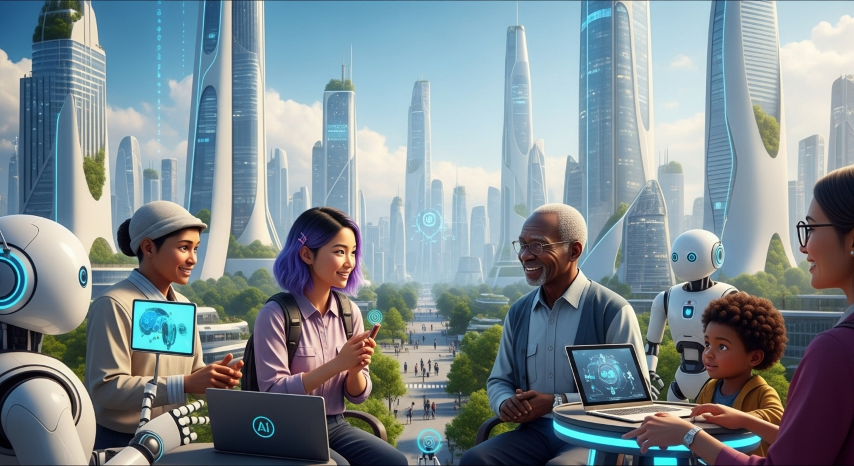Beyond Sci-Fi: 7 Ways AI is Already Making Your Life Easier (Without You Even Knowing It!)

Introduction: The Invisible Helper in Your Pocket (and Everywhere Else)
Picture this: It’s Friday night. You collapse onto the couch, open Netflix, and boom - right there is exactly the quirky sci-fi comedy you’re craving. How did it know? Or when your phone magically predicts your next text message word. Ever marveled at Google Maps rerouting you around traffic?
If these sound familiar, you’ve already used Artificial Intelligence (AI). Forget Hollywood robots - real AI is quietly embedded in your daily routines, making things smoother and more personalized. This is your guide to AI in everyday life - we’ll reveal simple, practical examples that show how AI works as your invisible helper.
What Exactly Is AI? (No PhD Required!)
Artificial Intelligence (AI) simply means computer systems that perform tasks requiring human-like intelligence:
- Learning from experience (like understanding your music taste)
- Recognizing patterns (spotting spam emails)
- Understanding language (Siri/Google Assistant)
- Solving problems (finding fastest routes)
- Making decisions (product recommendations)
Key difference from regular software: AI learns from data. It analyzes massive information (photos, behavior patterns, etc.) to improve at specific tasks.
Two Crucial AI Types:
- Narrow AI (Weak AI): The only real AI today. Excels at specific tasks (facial recognition, recommendations). This powers all everyday examples.
- Artificial General Intelligence (AGI): Hypothetical human-like intelligence (sci-fi territory). Doesn’t exist yet.
Think of everyday AI as your hyper-focused digital assistant - no consciousness, just math and pattern recognition to make your life easier.
7 Everyday AI Examples Explained: Your Digital Helpers Revealed
1. Your Smartphone: Pocket-Sized AI Powerhouse
- Facial Recognition: Uses neural networks to map facial geometry (distance between eyes, jaw shape). Learns your face over time.
- Predictive Text: Analyzes typing context, your habits, and common phrases to guess next words.
- Voice Assistants (Siri/Google): Combines speech-to-text, natural language processing (understanding intent), and response generation.
2. Streaming Services: Personal Entertainment Curators
- Recommendation Engines: Analyze:
- Your behavior (what you watch, skip, rate)
- Similar users' preferences
- Content attributes (genre, actors, tempo)
- Constantly refines suggestions based on new data.
3. Online Shopping: Virtual Shopping Assistant
- Personalized Suggestions: Analyzes:
- Your purchase/browsing history
- Wishlist items
- Similar shoppers' behavior
- Product attributes
- Predicts what you might buy and personalizes deals.
4. Navigation Apps: Real-Time Traffic Whisperers
- Real-Time Routing: Combines:
- Live location data from millions of users
- Historical traffic patterns
- Predictive modeling (weather/events)
- Instant rerouting algorithms
- Calculates fastest current route, not just shortest distance.
5. Email Spam Filters: Digital Bouncer
- AI Detection: Analyzes:
- Email content (keywords, structure)
- Sender reputation
- Metadata patterns
- Learns from global user spam reports and your personal markings.
6. Social Media Feeds: Personalized News Editors
- Content Ranking Algorithms: Prioritizes posts based on:
- Your engagement (likes, comments, watch time)
- Post popularity and recency
- Your relationship to the poster
- Designed to show content you’ll most likely engage with.
7. Customer Service Chatbots: First-Line Helpers
- Natural Language Processing (NLP):
- Understands query intent (“reset password” vs “track order”)
- Recognizes key details (order numbers)
- Pulls answers from knowledge bases
- Learns from past conversations
Why Should You Care About Everyday AI?
Understanding these simple AI examples matters because:
- Empowerment: Knowing how tools work helps you use them better (e.g., rating Netflix shows improves recommendations).
- Demystification: Reduces fear by revealing AI as task-specific tools, not sci-fi monsters.
- Future Readiness: AI will only grow more prevalent in healthcare, education, etc. Basic literacy prepares you.
- Informed Decisions: Helps you recognize AI’s influence (e.g., why you see certain social media posts).
- Curiosity Spark: Noticing everyday AI leads to deeper digital literacy.
Conclusion: Your First Step into a World Powered by Smart Helpers
Next time your phone unlocks instantly or Spotify suggests the perfect song - it’s not magic. It’s AI, your invisible assistant working behind the scenes. We’ve moved beyond sci-fi to reveal 7 simple AI examples in your daily routine.
Understanding what is AI for beginners means recognizing the pattern-spotting helpers that save you time and personalize your world. Remember: AI in everyday life is “Narrow AI” - brilliant specialists, not all-knowing overlords.
Your action step: Start noticing AI around you. When you see smart recommendations or time-saving automations, recognize the tech at work. Ready to learn more? Explore how AI is transforming healthcare, creative work, and other fields [link to your blog].
AI isn’t scary future tech - it’s the helpful force making your commute smoother and entertainment better. Welcome beyond the myths!

